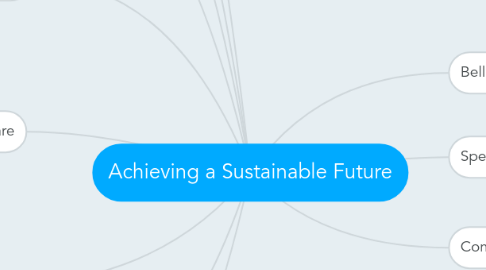
1. Living Planet Index
1.1. Definition: A specific indicator, created by the World Wildlife Fund, to measure that state of the world's biodiversity
1.1.1. Example: -39% marine species decline 39 percent from 1970-2010
2. Ecological Footprint
2.1. Definition: A measure of sustainability in which a unit of land area is used to demonstrate the ecological pressure created by residents of a country. EF is based on the principal that human activities are related to an amount of land needed to support them
2.1.1. Example: A vegetarian has a smaller footprint than someone who eats meat
3. Index of Sustainable Economic Welfare (ISEW)
3.1. Definition: An alternative measure to the GDP that adjusts conventional measures of economic progress in two ways, positively for factors that improves societal well-being and negatively for consumption patterns that are non-sustainable
3.1.1. Example: education, poverty, jobs
4. Fair Earthshare
4.1. Definition: Within the idea of ecological footprint, this is the amount of land available to support each person if all the productive land on Earth were divided evenly among all people in the world
4.1.1. Example: 80 percent of fossil fuel is extracted each year
5. Genuine Program Indicator
5.1. Definition: uses economic, social and environmental indicators like the ISEW, attempts to measure genuine progress by adjusting its measurement positively and negatively according to how an activity affects people's well-being
5.1.1. Example: in 2003 in the Pembina Institute, an environmental organization in Alberta applied the GPI to Alberta. It used a total of 51 economic, social, environmental indicators to compile information about the economic and social progress of the province
6. Extended Producer Responsibility
6.1. Defintion: A corporate and public policy in which the manufacturer is deemed responsible for the environmental impact of its product's packaging and the product itself during the entire lifespan.
6.1.1. Example: tires, computers and phones
7. Green Taxation
7.1. Definition: taxation imposed to encourage environmentally responsible behaviour
7.1.1. Example: Carbon Tax
8. Slow Cities
8.1. Definition: Cities that protect and encourage local and develop an economy based on the communities unique nature
8.1.1. Example: tour around to different cities, try different culture foods
9. Smart Growth
9.1. Defintion: Economic growth that occurs while sustainability is maintained. Smart growth occurs as a result of environmentally wise choices made by governments, businesses and people regard to their lifestyle.
9.1.1. Example: conserving farm land, increasing housing density along transit nodes
10. Bellagio Principal
10.1. Definition: A set of guidelines established in 1996 to assess the accuracy of measures of sustainable development
11. Specific Indicator
11.1. Definition: A single measure that shows the progress towards sustainability
11.1.1. Example: changes in greenhouse gas emissions over time
12. Comprehensive Indicator
12.1. Definition: A measure that shows overall progress toward sustainability
12.1.1. Example: the ecological footprint relates to the amount of land needed to support various human activities

